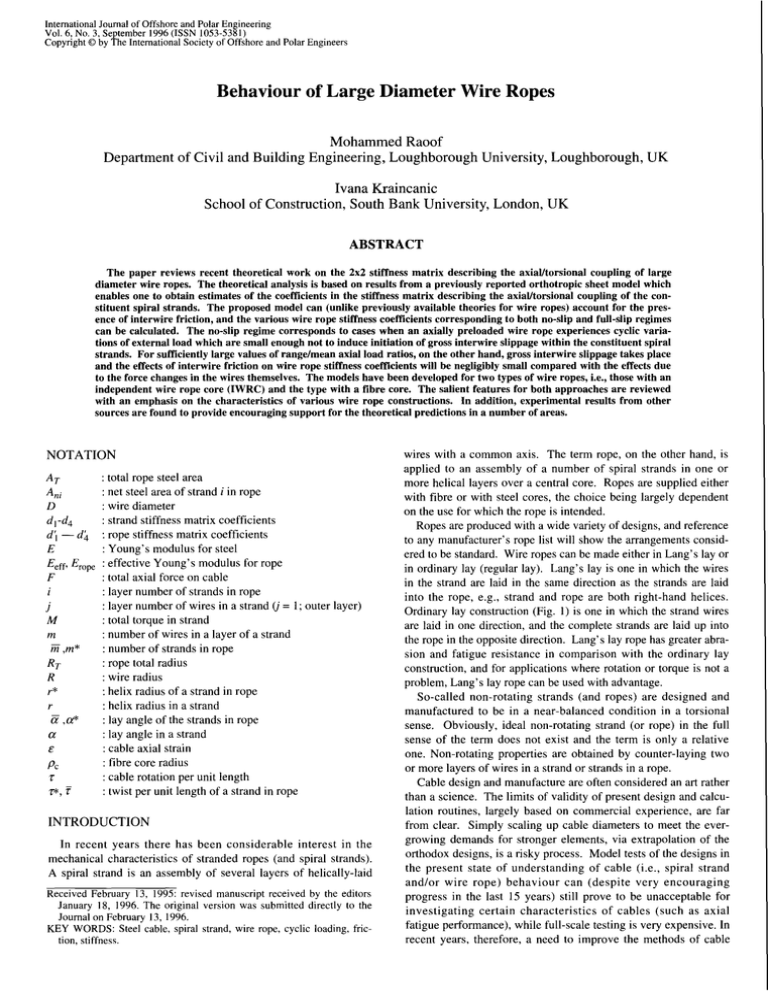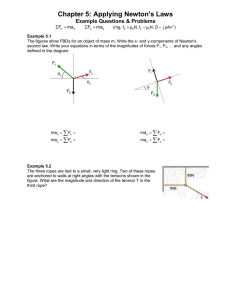Behaviour of Large Diameter Wire Ropes
advertisement

International Journal of Offshore and Polar Engineering Vol. 6, No.3, September 1996 (ISSN 1053-5381) Copyright © by The International Society of Offshore and Polar Engineers Behaviour of Large Diameter Wire Ropes Mohammed Raoof Department of Civil and Building Engineering, Loughborough University, Loughborough, UK Ivana Kraincanic School of Construction, South Bank University, London, UK ABSTRACT The paper reviews recent theoretical work on the 2x2 stiffness matrix describing the axial/torsional coupling of large diameter wire ropes. The theoretical analysis is based on results from a previously reported orthotropic sheet model which enables one to obtain estimates of the coefficients in the stiffness matrix describing the axial/torsional coupling of the constituent spiral strands. The proposed model can (unlike previously available theories for wire ropes) account for the presence of interwire friction, and the various wire rope stiffness coefficients corresponding to both no-slip and full-slip regimes can be calculated. The no-slip regime corresponds to cases when an axially preloaded wire rope experiences cyclic variations of external load which are small enough not to induce initiation of gross interwire slippage within the constituent spiral strands. For sufficiently large values of range/mean axial load ratios, on the other hand, gross interwire slippage takes place and the effects of interwire friction on wire rope stiffness coefficients will be negligibly small compared with the effects due to the force changes in the wires themselves. The models have been developed for two types of wire ropes, i.e., those with an independent wire rope core (IWRC) and the type with a fibre core. The salient features for both approaches are reviewed with an emphasis on the characteristics of various wire rope constructions. In addition, experimental results from other sources are found to provide encouraging support for the theoretical predictions in a number of areas. NOTATION AT D d)-d4 d')-d4 E Eeff, Erope F j M m m,m* r* r : rope stiffness matrix coefficients : Young's modulus for steel : effective Young's modulus for rope : total axial force on cable : layer number of strands in rope : layer number of wires in a strand (j = I; outer layer) : total torque in strand : number of wires in a layer of a strand : number of strands in rope : rope total radius : wire radius : helix radius of a strand in rope : helix radius in a strand a ,a* a E Pc T 7*, : total rope steel area : net steel area of strand in rope : wire diameter : strand stiffness matrix coefficients i Ani f : lay angle of the strands in rope : lay angle in a strand : cable axial strain : fibre core radius : cable rotation per unit length : twist per unit length of a strand in rope INTRODUCTION In recent years there has been considerable interest in the mechanical characteristics of stranded ropes (and spiral strands). A spiral strand is an assembly of several layers of helically-laid Received February 13, 1995: revised manuscript received by the editors January 18, 1996. The original version was submitted directly to the Journal on February 13, 1996. KEY WORDS: Steel cable, spiral strand, wire rope, cyclic loading, friction, stiffness. wires with a common axis. The term rope, on the other hand, is applied to an assembly of a number of spiral strands in one or more helical layers over a central core. Ropes are supplied either with fibre or with steel cores, the choice being largely dependent on the use for which the rope is intended. Ropes are produced with a wide variety of designs, and reference to any manufacturer's rope list will show the arrangements considered to be standard. Wire ropes can be made either in Lang's lay or in ordinary lay (regular lay). Lang's lay is one in which the wires in the strand are laid in the same direction as the strands are laid into the rope, e.g., strand and rope are both right-hand helices. Ordinary lay construction (Fig. 1) is one in which the strand wires are laid in one direction, and the complete strands are laid up into the rope in the opposite direction. Lang's lay rope has greater abrasion and fatigue resistance in comparison with the ordinary lay construction, and for applications where rotation or torque is not a problem, Lang's lay rope can be used with advantage. So-called non-rotating strands (and ropes) are designed and manufactured to be in a near-balanced condition in a torsional sense. Obviously, ideal non-rotating strand (or rope) in the full sense of the term does not exist and the term is only a relative one. Non-rotating properties are obtained by counter-laying two or more layers of wires in a strand or strands in a rope. Cable design and manufacture are often considered an art rather than a science. The limits of validity of present design and calculation routines, largely based on commercial experience, are far from clear. Simply scaling up cable diameters to meet the evergrowing demands for stronger elements, via extrapolation of the orthodox designs, is a risky process. Model tests of the designs in the present state of understanding of cable (i.e., spiral strand and/or wire rope) behaviour can (despite very encouraging progress in the last 15 years) still prove to be unacceptable for investigating certain characteristics of cables (such as axial fatigue performance), while full-scale testing is very expensive. In recent years, therefore, a need to improve the methods of cable


